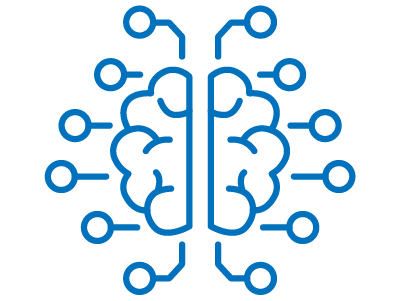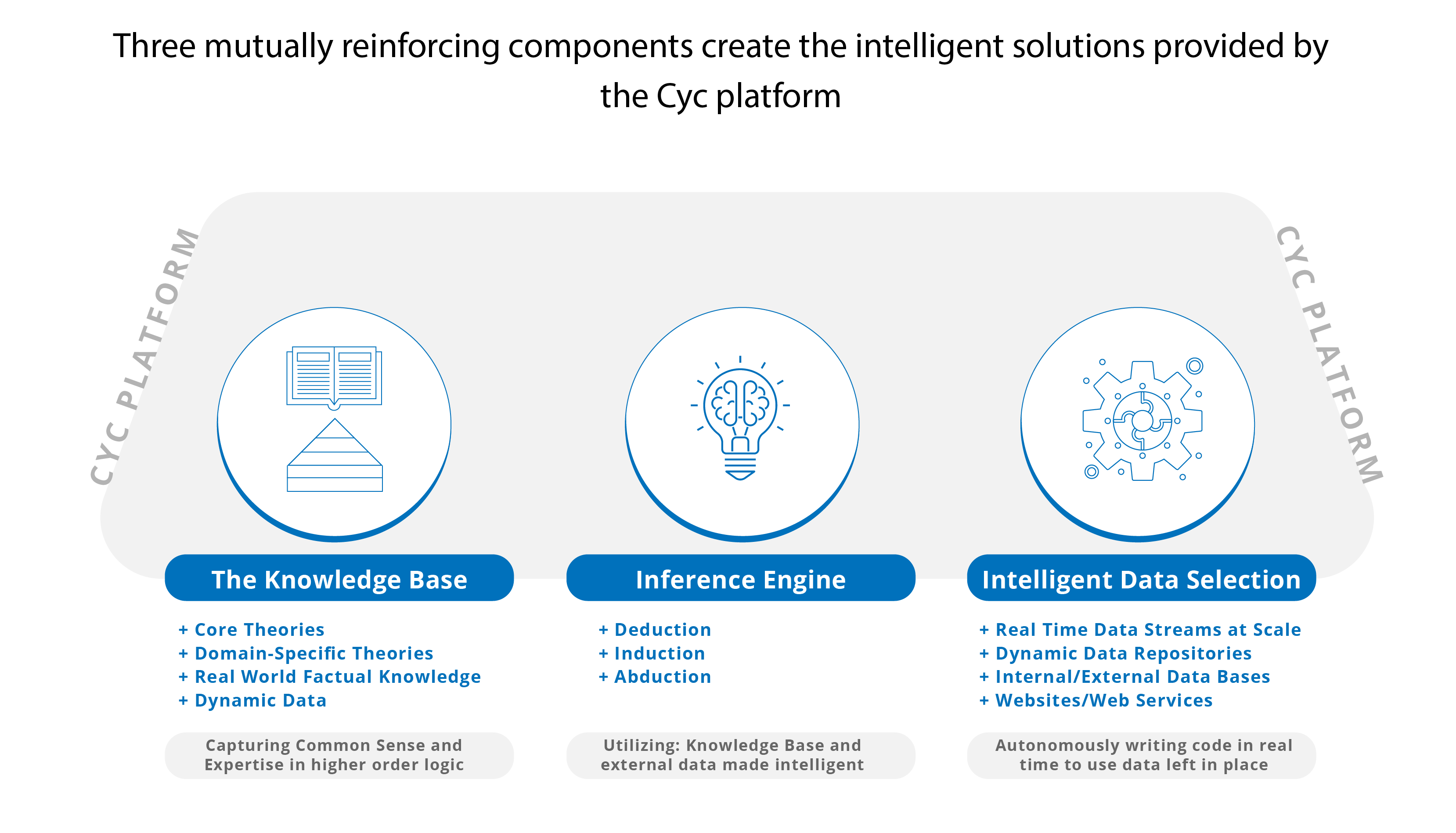Enterprises use our Machine Reasoning AI to transform and augment complex, human workloads.

CYC is Machine Reasoning AI that uses codified human common sense and knowledge (not patterns and statistics) for human-like cognitive processing.

CYC can logically reason using dynamic, real-world data… just like your best employee.

CYC has the ability to fundamentally transform or augment all complex, human workloads.
Machine intelligence for enterprise

THe Knowledge base
The World’s Broadest and Deepest Common Sense Knowledge Base
Practical, Retargetable, and Reusable Real-World Knowledge
Cyc has the world’s broadest and deepest common sense knowledge base (KB), by orders of magnitude. The KB is not a database – it consists of real world axioms that Cyc uses to reason about the world and understand your data.
Cyc’s KB includes more than 40,000 predicates, millions of collections and concepts, and more than 25 million axioms. When coupled with the inference engines, Cyc can quickly prove trillions of bits of usable, real world knowledge.
CYC’S KNOWLEDGE BASE:
- 40,000+ Predicates (to express reusable relationships)
-
1,500,000+ Concepts
- 25,000,000+ Explicitly-stated axioms
- Trillions+ Implicit axioms, real-world knowledge


Higher Order Logic
The KB is also distinguished by its expressiveness. Cyc’s knowledge is expressed in a higher-order logic. While the details of this are important and interesting to logicians, the upshot can be clearly seen in contrast with triplestores (RDF stores). Triplestores are so-called because they take three arguments: subject, object, and a relation between them. Triplestores are often represented graphically, with two nodes connected by some directed relational arrow. This is useful for saying things like the following:
Casey works as an engineer.
The triplestore can then relate the object <Casey> to the object <engineer> by the <works as a> relation. However, English sentences, and the propositions that they represent, are often much more complicated than these two-place relations can handle. Consider:
Casey believes that Lara performed the patient examination.
The latter part, “Lara performed the patient examination”, is amenable to a triplestore, but nesting that sentence inside a “Casey believes” component is very complicated to represent in such a framework. On the other hand, Cyc’s language, CycL, is expressive enough that you can say anything in CycL that you can say in English. This means that your valuable and nuanced domain knowledge will not need to be oversimplified in order for Cyc to understand it.
Cyc’s inference engines
1100+ Inference Engines logically combine pieces of knowledge
Combines with Cyc’s massive Knowledge Base and external data sources
While the KB is what Cyc knows, this knowledge will only be useful if Cyc can efficiently reason over that massive store of knowledge.
Cyc is unique because it harnesses 1100+ inference engines to logically combine pieces of knowledge from its KB and relevant internal and external data sources. This allows Cyc to quickly produce arguments that are hundreds or even thousands of steps long in real time. Each individual inference engine is suited for a specific task, such as checking for a fact in a database, performing a graph walk on our generalization predicate (#$genls), or performing transitivity reasoning. For any given task, Cyc is able to use meta-reasoning to determine which inference engine is right for the job.

While the size of the KB is impressive, Cycorp’s chief goal is quality over quantity. Knowledge is represented generally as possible so that it can be broadly reused and efficiently reasoned with.
For example, rather than express that “nurses require medical training” and “doctors require medical training” and “paramedics require medical training”, Cyc only has one assertion that all medical professionals require medical training. In terms of counting, this is just one piece of knowledge, but that knowledge can be efficiently re-targeted to prove the relevant claim for any particular type of medical professional.
For another example, Cyc knows that “If a conduit is pinched, then pressure builds upstream and decreases downstream.” This fact about fluid dynamics applies to blood in veins, oil in pipes, milkshakes in drinking straws, and so on.
Meta-Reasoning
Cyc reasons using deduction, induction (by using the entire KB as a symbolic learning bias), and abduction (by using the KB to evaluate plausibility). Deductive arguments allow Cyc to prove that a certain thing must be true given a set of assumptions. Inductive arguments allow Cyc to reason about what is likely true given some basis of experience. Abductive arguments allow Cyc to infer what might be the case as the best explanation for a given set of observations; for example, if we observe a car stopped at a green light, we might justifiably infer that the driver is distracted or that the car is suffering from some sort of mechanical failure.
Automated intelligent data SELECTION
Cyc is not restricted to its Knowledge Base.
Cyc can be taught to access external data sources, understanding data in days, not weeks or months.
In recent years, companies have realized that data is a valuable asset that can be used to derive insights and improve business outcomes. The Cyc Knowledge Base is a source of power that can be leveraged to enrich your data and uncover its latent value.
There are two ways that Cyc integrates with external knowledge and data. For external ontologies — sources that provide relatively static, general, re-usable, type level information (“knowledge” rather than “data”) — we typically import their content into the knowledge base.


Automated External Ontology Acqusition
Cyc has automated tools for importing external ontologies. Once an ontology is imported, that knowledge can be used by the Cyc inference engine. Since CycL is a much more flexible and expressive representation language than ontology standards like OWL / RDF, importing an ontology into Cyc can allow you to create abstractions over the knowledge therein that make it easier to work with and reason about.
But for most data sources, Cyc uses a powerful system called Semantic Knowledge Source Integration (SKSI) to access the data where it lives on demand. The ability to access a variety of data sources “in situ” without migrating the data to a data warehouse sets Cyc apart for machine learning techniques which require that move all of your data into a curated dataset before you can start generating value.
